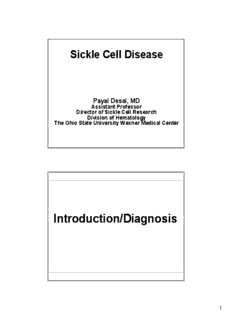
Sickle Cell Anemia Management Final Handout PDF
Preview Sickle Cell Anemia Management Final Handout
Sickle Cell Disease Payal Desai, MD Assistant Professor Director of Sickle Cell Research Division of Hematology The Ohio State University Wexner Medical Center IInnttrroodduuccttiioonn//DDiiaaggnnoossiiss 1 EElleeccttrroopphhoorreettiicc ppaatttteerrnnss iinn CCoommmmoonn HHeemmoogglloobbiinnooppaatthhiieess Condition Hb A Hb S Hb C Hb F Hb A2 Normal 95-98 0 0 <1 <3.5 Beta thal minor 90-95 0 0 1-3 >3.5 Sickle cell trait 50-60 35-45 0 <2 <3.5 Sickle-beta (+) thal 5-30 65-90 0 2-10 >3.5 Sickle-beta (0) thal 0 80-92 0 2-15 >3.5 Sickle-Hb C disease 0 45-50 45-50 1-8 <3.5 Sickle cell anemia 0 85-95 0 2-15 <3.5 _______________________________________________ 2 PPaatthhoopphhyyssiioollooggyy SSiicckkllee CCeellll AAnneemmiiaa PPaatthhoopphhyyssiioollooggyy Sickle cell anemia (SCA) is the classical example of a genetic (or molecular) disorder Beta chain of Hemoglobin A ……………..GAG….…………………. ……………..6 Glu…………………….. Beta chain of Hemoglobin S ……………..GTG….…………………. ……………..6 Val…………………….. 3 GGeenneettiiccss • Haplotypes of Sickle Cell Disease: Gabriel, A. & Przybylski, J. (2010) Sickle-cell anemia: A Look at Global HaplotypeDistribution. Nature Education 3(3):2 SSiicckkllee CCeellll AAnneemmiiaa PPaatthhoopphhyyssiioollooggyy • Manifestations of SCD are driven by 2 major processes: • Vaso-occlusion with ischemia- reperfusion injury • Hemolytic anemia 4 PPaatthhoopphhyyssiioollooggyy • Polymerization of deoxygenated HbS – primary event in pathogenesis of SCD • Rate and extent of polymer formation in sickle RBC depends on several variables: • The cell’s degree of deoxygenation • The intracellular hemoglobin concentration • The presence or absence of hemoglobin F SSiicckkllee CCeellll AAnneemmiiaa PPaatthhoopphhyyssiioollooggyy • Not just RBCs: • Platelet Activation • Endothelial Activation • Neutrophil Transmigration 5 CClliinniiccaall CCoommpplliiccaattiioonnss && TThheerraappyy CCoommpplliiccaattiioonnss ooff SSCCDD Konotey-Ahulu FID. The Sickle Cell Disease. Clinical Manifestations Including the “Sickle Crisis”. Arch Intern Med.1974;133(4):611-619. 6 MMoorrttaalliittyy iinn SSiicckkllee CCeellll DDiisseeaassee Childhood mortality rates in SCD - In 1973 – median survival of 14.3 years - CSSCD ~ 85% SS children and adolescents with survived to age 20 - In 2004 survival analysis of SS and Sβ° subjects SCD-related survival 93.6% by age 18 Diggs LM. Anatomic lesions in sickle cell disease. Sickle cell disease: diagnosis, management, education and research. St. Louis: C.V. Mosby, 1973:189-229 LeikinSL, Gallagher D, Kinney TR, Sloane D, Klug P, RidaW. Mortality in children and adolescents with sickle cell disease. Pediatrics 1989;84:500-508 Platt et al. Mortality In Sickle Cell Disease –Life Expectancy and Risk Factors for Early Death. N EnglJ Med 1994; 330:1639-1644 Quinn C T et al. Survival of Children with Sickle Cell Disease. Blood 2004;103:4023-4027 MMoorrttaalliittyy iinn SSiicckkllee CCeellll DDiisseeaassee Childhood mortality rates in SCD - In 1973 – median survival of 14.3 years - CSSCD ~ 85% SS children and adolescents with survived to age 20 - In 2004 survival analysis of SS and Sβ° subjects SCD-related survival 93.6% by age 18 Diggs LM. Anatomic lesions in sickle cell disease. Sickle cell disease: diagnosis, management, education and research. St. Louis: C.V. Mosby, 1973:189-229 LeikinSL, Gallagher D, Kinney TR, Sloane D, Klug P, RidaW. Mortality in children and adolescents with sickle cell disease. Pediatrics 1989;84:500-508 Platt et al. Mortality In Sickle Cell Disease –Life Expectancy and Risk Factors for Early Death. N EnglJ Med 1994; 330:1639-1644 Quinn C T et al. Survival of Children with Sickle Cell Disease. Blood 2004;103:4023-4027 7 CCaarrddiioovvaassccuullaarr CCoommpplliiccaattiioonnss ooff SSCCDD Acute Complications Chronic Complications • Acute Chest • Cardiomyopathy Syndrome • Pulmonary • Pulmonary Embolism Hypertension • Ventricular Arrhythmias • Myocardial Ischemia • Risk of Sudden Death AAccuuttee CChheesstt SSyynnddrroommee DDeeffiinniittiioonn • Charache suggested this name in 1979 for what he felt was a poorly understood process • A new pulmonary infiltrate in a clinically ill patient with sickle cell disease • Fever, cough, chest pain, tachypnea, wheezing, rales on exam 8 AAccuuttee CChheesstt SSyynnddrroommee -- CClliinniiccaall PPrreesseennttaattiioonn • Frequency of ACS is dependent on genotype and baseline hemoglobin level • Young children (2 – 4 yrs): fever, cough, wheezing and rarely have pain • Adults: Often afebrile, SOB, and with severe pain • X-ray findings: upper lobe in children; multilobe/lower lobe in adults • Children < blood transfusions than adults • Hospitalization is ~ 5.4 days in children vs ~ 9 days in adults AAccuuttee CChheesstt SSyynnddrroommee -- MMoorrttaalliittyy • Patients with higher ACS rate have higher rate of mortality than those with low ACS rate • Increased rate of mortality may contribute to decline in ACS rate with age Castro, et al., Blood, 1994 9 AAccuuttee CChheesstt SSyynnddrroommee TTrreeaattmmeenntt • Broad spectrum antibiotics – cephalosporin + macrolide • Bronchodilator, incentive spirometry chest PT • RBC transfusion (Simple vs Exchange) • Phenotypically matched RBC • Experimental treatments • Steroids • Inhaled nitric oxide AAccuuttee CChheesstt SSyynnddrroommee PPrreevveennttiioonn • Hydroxyurea – known to decrease the frequency of acute chest syndrome • Incentive Spirometry • Gentle Hydration 10
Description: